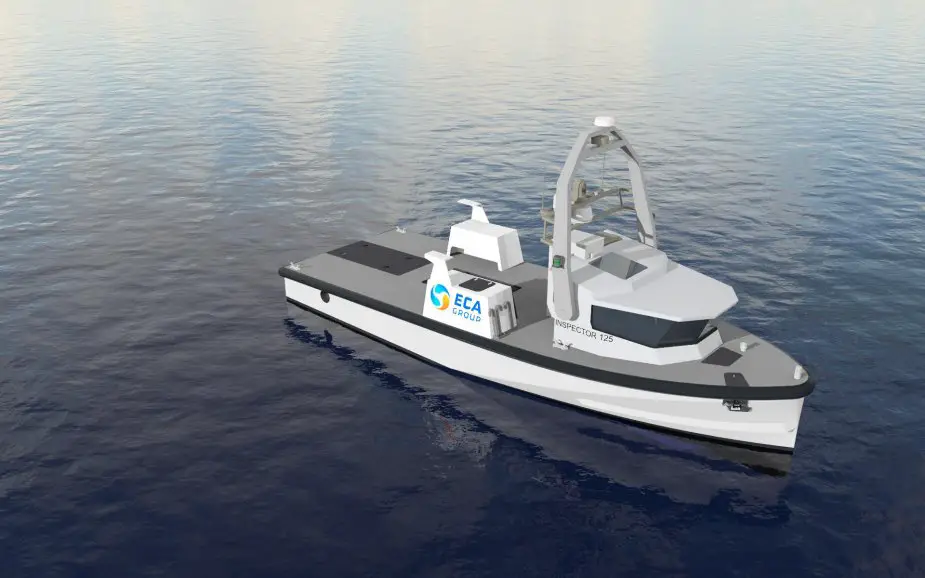According to a press release published by ECA Group on March 4, 2021, within their Mine Countermeasures capability replacement programme, the Belgian and the Royal Netherlands navies chose the INSPECTOR 125-class USV.
Follow Navy Recognition on Google News at this link
 Artist rendering of INSPECTOR 125 USV (Picture source: ECA GROUP)
Artist rendering of INSPECTOR 125 USV (Picture source: ECA GROUP)
The INSPECTOR 125 USV has a low magnetic and acoustic signature to prevent mine triggering, and its unsinkability keeps it afloat in the event of mine explosions. He is designed to integrate different payloads depending on the mission to be performed. Changing from one configuration to another takes less than 6 hours. The drone will be able to accommodate either the AUV and its LARS in "taxi mode", or the towed sonar, or MIDS (Mine Identification and Disposal system), or divers and protection units.
He is thus a sea proven, robust, unsinkable USV, operable by sea state 4, multipurpose by design. His platform has a 12,3m-long overall length. It is equipped with two engines and two waterjets allowing it to reach 25 knots. It has an endurance of 48 hours by sea state up to 4.
A variant of the INSPECTOR 125 platform is dedicated for the IMS mission (Influence Mine Sweeping). For this INSPECTOR 125-S variant, the waterjets are replaced by two shaft lines with propellers to increase the thrust allowing the sweep to be towed at up to 8 knots. This variant’s maximum speed is 13 knots.
The drone is equipped with foamed compartments, which makes this USV unsinkable and therefore, more resistant in case of mine explosions or perils of the sea. The INSPECTOR 125 inherits from the V2 NG lifeboat its robustness, reliability and unsinkability and its ideal compromise between speed, seakeeping and manoeuvrability.
The USV is equipped with a "Sea Proven" anti-roll system, which reduces roll by 40%. Thanks to this mechanism, the USV is operational up to sea state 4 and ensures the launching and recovery of the underwater vehicles – AUV (Autonomous Underwater Vehicle), Towed Sonar, ROV (Remotely Operated Vehicle) - by high sea states.
The INSPECTOR 125 USV can be configured according to the payload. The USV is equipped with a generic power and control cabinet compatible with all payloads, a hydraulic power unit to ensure the functions of the T18 Towed Sonar LARS and the deployment of the mature, as well as its pole equipped with an acoustic tracking and communication system and the MOAS (Mine and Obstacle Avoidance Sonar).
In AUV or Towed Sonar configuration, the drone transits at high speed while carrying the A18-M AUV or T18 Towed Sonar to/from the mine threat area, thus increasing the payload operational time on target and effective mission duration otherwise limited by the battery consumption during transit from the ship. The INSPECTOR 125 then launches/recovers the A18 AUV or T18 Towed Sonar, while supporting the payload during its mission.
In MIDS configuration, the INSPECTOR 125 USV is fitted with ROVS: the SEASCAN and its LARS for identification, as well as the K-STER C and its canister for neutralization at stand-off distances.
The main innovation of the USV is its ability to execute mine countermeasures missions with a high level of autonomy at a stand-off distance of up to 18 NM from a mothership. This range can be further extended via the SKELDAR V-200 UAV communication relay.
The obstacle identification system is based on a perception module that merges data from several sensors, including AIS, RADAR, MOAS, and cameras and informs the obstacle avoidanc
The broadband radio link provides high speed communication, high capacity data transfer and anti-jamming capabilities. The antenna diagram allows to maintain strong link margin even with platform motion due to high sea states.
The INSPECTOR 125 is also equipped with a Mine and Obstacle Avoidance Sonar (MOAS), offering mine detection and classification performance never achieved before. The MOAS is a key element that ensures the detection of both mine-like-objects and obstacles near the surface, which may represent a direct threat to the USV itself, as well as objects deep in the water column or on the seafloor, which may be a mine threat.
The drone includes state of the art cybersecurity rules, encapsulated network architecture, using a defence in depth approach with layered protections compliant with NATO standards and ANSSI (French National Cybersecurity Agency of France) recommendations. All communications on radio frequencies, satellite and underwater acoustic are protected and authenticated by advanced encryption algorithms.
ECA GROUP will deliver 17 INSPECTOR 125 USVs from 2023.



